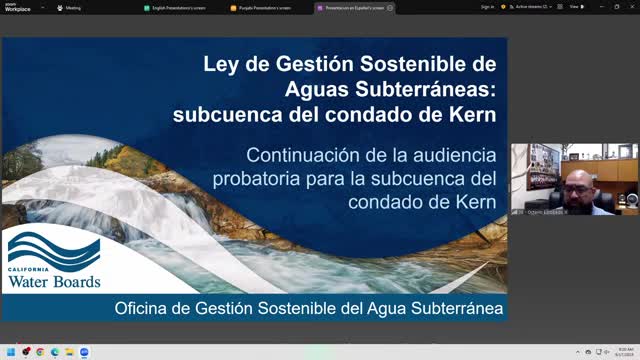Kern County Water Management Board Reviews 2025 Groundwater Sustainability Plan
September 18, 2025 | State Water Resources Control Board, Boards and Commissions, Executive, California
This article was created by AI summarizing key points discussed. AI makes mistakes, so for full details and context, please refer to the video of the full meeting. Please report any errors so we can fix them. Report an error »

The recent State Water Resources Control Board (SWRCB) meeting held on September 17, 2025, focused on critical discussions surrounding groundwater management in California, particularly in the Kern County sub-basin. The meeting highlighted the ongoing efforts to ensure sustainable water practices in the region, which is vital for local communities reliant on groundwater for agricultural and domestic use.
Key discussions centered on the implementation of the Sustainable Groundwater Management Act (SGMA), which mandates that local agencies develop Groundwater Sustainability Plans (GSPs) to manage groundwater resources effectively. The board emphasized the importance of these plans in addressing issues such as declining groundwater levels and water quality degradation. The presentation included an overview of the Kern County sub-basin, which spans over 1.9 million acres and serves a population of approximately 736,000 residents.
The board reviewed the progress made since the last public hearing in February 2025, noting that various Groundwater Sustainability Agencies (GSAs) have been working collaboratively to gather data and develop strategies to meet sustainability goals. The meeting also addressed the need for community engagement, with agencies encouraged to improve communication and outreach efforts to ensure that all stakeholders, including non-English speaking residents, are informed and involved in the groundwater management process.
In addition to the primary focus on groundwater sustainability, the board discussed the implications of potential state intervention if local agencies fail to meet established benchmarks. This could lead to increased oversight and support from the state to ensure that groundwater resources are managed responsibly.
As the meeting concluded, the SWRCB reiterated its commitment to supporting local agencies in their efforts to achieve sustainable groundwater management. The board's actions and decisions will play a crucial role in shaping the future of water resources in Kern County and beyond, directly impacting the livelihoods and well-being of residents who depend on these vital resources. The next steps will involve continued monitoring and collaboration among local agencies to address the challenges ahead.
Key discussions centered on the implementation of the Sustainable Groundwater Management Act (SGMA), which mandates that local agencies develop Groundwater Sustainability Plans (GSPs) to manage groundwater resources effectively. The board emphasized the importance of these plans in addressing issues such as declining groundwater levels and water quality degradation. The presentation included an overview of the Kern County sub-basin, which spans over 1.9 million acres and serves a population of approximately 736,000 residents.
The board reviewed the progress made since the last public hearing in February 2025, noting that various Groundwater Sustainability Agencies (GSAs) have been working collaboratively to gather data and develop strategies to meet sustainability goals. The meeting also addressed the need for community engagement, with agencies encouraged to improve communication and outreach efforts to ensure that all stakeholders, including non-English speaking residents, are informed and involved in the groundwater management process.
In addition to the primary focus on groundwater sustainability, the board discussed the implications of potential state intervention if local agencies fail to meet established benchmarks. This could lead to increased oversight and support from the state to ensure that groundwater resources are managed responsibly.
As the meeting concluded, the SWRCB reiterated its commitment to supporting local agencies in their efforts to achieve sustainable groundwater management. The board's actions and decisions will play a crucial role in shaping the future of water resources in Kern County and beyond, directly impacting the livelihoods and well-being of residents who depend on these vital resources. The next steps will involve continued monitoring and collaboration among local agencies to address the challenges ahead.
View full meeting
This article is based on a recent meeting—watch the full video and explore the complete transcript for deeper insights into the discussion.
View full meeting
